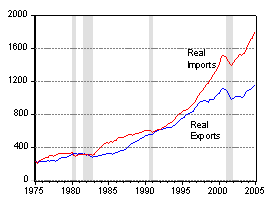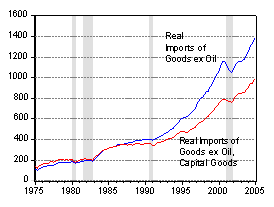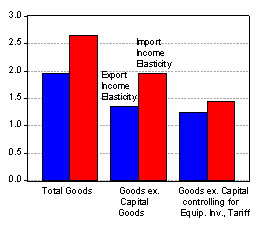Does the cross-border fragmentation of production mean that measured trade flows are irrelevant?
The BEA’s advance release for 2005q4 GDP and net exports won’t come out until the 27th of this month, but now seems a good time to step back and consider what conditions will induce a reduction in the trade deficit. (This analysis is drawn from this paper; the graphs report data from the July 2005 release).
In order to take in the big picture, it is necessary to remember that not only do imports far exceed exports, thereby requiring more rapid growth in exports than imports just to keep the balance constant. The proximate cause for this situation is that (1) U.S. growth has exceeded its counterparts, and (2) the income elasticity of U.S. imports exceeds the income elasticity of U.S. exports with respect to rest-of-world income. The second stylized fact, termed the Houthakker-Magee effect, has persisted over over the past 30 years. The gap in elasticities is at least 0.3 for total goods and services. In Chinn (2005), the gap is as high as 0.65. Furthermore, there is little evidence that the asymmetry is disappearing.
In addition, the absolute values of the income elasticities are quite high. They range as high as 2.3 for imports, and 2.0 for exports. These large elasticities are difficult to reconcile with the standard differentiated goods model. From a forecasting standpoint, high income elasticities are not troubling; but from an economic perspective, they are perplexing. In addition, the behavior of trade flows during 1999-2000 is difficult to explain using standard models. As illustrated in the figure below, both series surge in this period.

Flows in billions of 2000Ch$, SAAR. Source: Chinn, “Supply Capacity,
Vertical Specialization
and Tariff Rates,” NBER Working Paper No. 11719 (Oct. 2005).
Some people argue that traditional measures of trade flows and current account balances don’t matter; that many of the imports are from U.S. affiliates, or are used subsequently for exports. I disagree; these flows matter because they measure, to some extent, the trade in goods and services produced using factors of production located in the United States, versus those produced outside the U.S. That does not mean that these issues are unimportant. The trade in intermediate goods used in producing exports (as opposed to used in prouducing domestically consumed goods), does matter insofar as we miscount traded output. The rising share of intermediate goods used in producing exported goods is called vertical specialization by Hummels,Ishii, and Yi (Yi estimates about a third of intra-OECD trade is associated with vertical specialization) or production fragmentation by Arndt and others (here is a nontech description by way of Crooked Timber). (By the way, this is why even though services trade appears to be a small factor in U.S. international trade, it actually is fairly important to the extent that there is less vertical specialization in services trade). What are the real world counterparts to this trade in intermediate goods? Capital goods trade is one proxy.
What is the implication of this for trade flows? This suggests that a lot of the high measured income elasticities could be an artifact of this effect, and at the same time could explain the hump in imports and exports around 2000. In the two figures below, exports of goods and exports of goods excluding capital goods are shown, and the corresponding imports (ex. oil) series.


Flows in billions of 2000Ch$, SAAR. Source: Chinn, “Supply Capacity, Vertical Specialization
and Tariff Rates,” NBER Working Paper No. 11719 (Oct. 2005).
Vertical specialization — and hence measured trade flows — increases with tariff rates, and these rates have been declining over the post-War era. Regressing total goods flows on incomes thus might yield a misleadingly high estimate of income elasticities. It turns out that if one removes capital goods, the absolute elasticities decline (see the next figure which displays the elasticities estimated by dynamic OLS), but the gap remains the same. Controlling this same aggregate (goods ex. capital goods) with domestic physical investment in equipment and the tariff rate yields even lower estimated elasticities, much closer in line with expected (around unity). In addition, the asymmetry largely disappears.

Source: Chinn, “Supply Capacity, Vertical Specialization
and Tariff Rates,” NBER Working Paper No. 11719 (Oct. 2005).
It is important to note that there is considerable uncertainty regarding these estimates. And these estimates are sensitive to the treatment of time trends. (Also, because I have no estimate of foreign equipment investment, U.S. equipment investment is used in the export equation).
What does this mean for the adjustment process? Well, recall first that while the income elasticities are now closer to being equal, the fact that imports are so much greater than exports means that shrinking the deficit via realignment of trend income growth rates will be difficult. A similar point is made by Catherine Mann and Katerina Plueck, who use a much finer level of disaggregation to estimate their elasticities.
Another conclusion is that a resurgence in U.S. capital equipment investment would tend to increase the deficit, holding all else constant, while a resurgence abroad might spur faster realignment. That is why revived investment in Europe and Japan would be helpful in global rebalancing on the real side.
Of course, revived investment abroad would eliminate the “global savings glut” that has kept U.S. interest rates low and hence the U.S. net income account portion of the current account near zero. Further rising interest rates would tend to push the
net income account into the negative territory…
I’ve often wondered why we get worked up about trade deficits based on national boundaries, and not on state boundaries? Or cities, for that matter?
Why are we not concerned if Oregon, say, runs a trade deficit, while we are concerned if the US as a whole runs a trade deficit?
And while I’m at it, why do we not look at regional areas, such as say the NAFTA area. Does the NAFTA area run a trade deficit or a surplus?
Some dude: We care about inter-country trade flows partly because that is the data we collect. Typically, intra-country trade flows are not collected. More importantly, we care about inter-country trade flows because factors of production are not very mobile across country borders. That distinction distinguishes national borders from state borders.
Very good post.
From the ‘nontech description’ link:
“The current surge in imports is strongly related to our rising industrial output,” said Kathleen Cooper, under secretary for economic affairs at the Commerce Department. “Goods that are assembled in this country have an awful lot of imported components that used to be made in this country.”
That pretty well seals our fate, absent major shifts in currency valuations, purchasing patterns, or whatever else which could bring about a major surge in U.S. exports and/or domestic production of goods.
I was reviewing information last week which provides a table comparison of U.S. imports and exports by commodity group. Not a positive picture for U.S. factors of production.
We’re going to miss the industrial revolution.
And the extensive knowledge that so many individuals brought to the production table.
“Because it’s the data we collect” is a terrible answer, no offense intended. It’s probably more accurate than you want to admit, and it certainly makes one question the validity of the data and various interpretations of that data.
The factors of production seem pretty mobile to me, at least in the developed world– capital and labor certainly are mobile. Not quite as mobile between the US and France as between Oregon and Idaho, but in practical terms perhaps less than you might think.
I meant to end with “in practical terms perhaps the difference is less than you might think.”
Some Dude: I agree that data availability is a terrible reason to focus on intercountry trade flows. But, as I said, the more important reason was that intercountry flows are the more important variable to look at. That is the basis for dozens of international economics textbooks, and I have a suspicion they know something.
So let us discuss the issue of capital mobility. I think we can agree that labor mobility is hindered by explicit restrictions on labor flows, and the entire debate about asymmetric shocks in the euro-zone is based upon the idea that labor mobility between euro-zone countries is less than that between California and Arizona.
On capital mobility, we have several tests, including uncovered interest parity, covered interest parity, real interest parity, savings-investment correlations.
On uncovered interest parity, see this paper with Guy Meredith; for similar tests for emerging markets, see this paper with Rita Madarassy. With respect to the real interest parity criterion, see this paper with Eiji Fujii. In all these instances, while I find that interest parity holds better at long horizon, there remain substantial deviations from parity, if not in a statistical sense, then in an economics sense. And certainly for the emerging market economies, parity does not hold.
Finally, as Martin Feldstein pointed out over twenty years, ago, savings-investment correlations were too high to be rationalized by perfect capital mobility. That finding remains as true today as it did when he first reported it (that is the Feldstein-Horioka finding).
Hence, I feel relatively safe in saying that inter-country factor mobility remains (much) less than intra-country capital mobility.
Prof. Chinn, thanks for your thoughtful replies (and for putting up with my dumb questions!).
I have a naive question that I’m hoping you can help me with. Why are negative balances of trade necessesarily bad? Consider a case where a country (i.e. the U.S.) trades with another country (e.g. China) to the tune of, let’s say $100 billion, while running a large deficit ($10 billion). You’ve said this is unsustainable – but is it not possible that the trade itself generates more wealth than the deficit? In other words, trading “produces” e.g. $50 billion in wealth (through improved efficiencies or something); then in that case wouldn’t the U.S. see a net gain of $40 billion, China a net gain of $10 billion, and so the U.S. comes out ahead even if there is an apparent imbalance of $10 billion? What am I missing? Why do you treat foreign trade as if it were a zero-sum game? It seems to me that trade has to generate _some_ form of wealth or it wouldn’t happen…
My novice’s view of RayBender’s question:
Trade certainly creates wealth. No trade is conducted unless there is benefit to both parties.
With that being said: if Parties A and B keep trading and Party B runs low on funds, then the value of currency rises to B versus A.
This causes Party B to raise the price of goods he is selling to A, causing inflation in import prices for Party A. Rapidly, the playing field shifts to a new level of exchange rates and trading resumes.
Ricardo’s theory of Comparative Advantage stated that this trade creates wealth when factors of production are perfectly mobile, but by definition factors of production are quite mobile in the long run.
Does this withstand your scrutiny, Dr. Chinn?
RayBender: I didn’t mean to treat trade as a zero sum game. I agree that trade almost always increases welfare. My concern is not with trade per se, but rather the fact that current account deficits must imply a corresponding financial account inflow — borrowing.
If one believes this level of inflow (6.5% of GDP) is not optimal, then one would be interested in the manner in which it shrinks (which is thus related to the way in which the current account deficit shrinks). If you feel that this level is perfectly sustainable, and in fact should increase (a minority view I believe), then my discussion is moot.
Bob: I would characterize the simple Ricardian model as one of balanced trade, and trade can never worsen welfare relative to autarky (and you are right, intra-country labor mobility is perfect in this model). What you have described though is a Hume Price-Species-Flow mechanism appended to a Ricardian model, I think. It makes sense as a long run model of adjustment.
Why should we care about international trade? America is not very much dependnet on international trade. America’s import to GDP ratio is actually smaller than 0.15. Improving efficiency in the service sector is more important.
R-squared: I don’t want to deny the fact that productivity is very important. But that doesn’t mean that other things aren’t important. The US import to GDP ratio is over 16% as of 2005q3; the US trade deficit to GDP ratio, according to NIPA conventions, is over 5.8%, with no signs of shrinking. So just like I would be concerned about a relative who is spending in excess of 3% of his or her income each year over the past 6 years, I’m concerned about the way in which consumption will be adjusted to income some time in the future. I agree that if my relative becomes more productive sometime in the future, that might assuage my concerns — but it doesn’t make my concern about the deficit disappear.
And to continue with the analogy, think about what would be the case if that relative has to shave off that 5.8% deficit not off his/her total income, but rather on one-third of his/her income. Well, that’s the issue that Obstfeld and Rogoff highlighted when they pointed out that adjustment has to take place on the tradables sector.